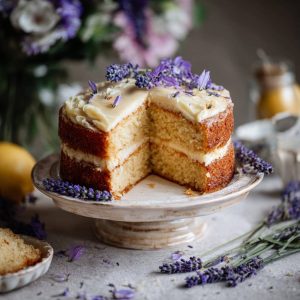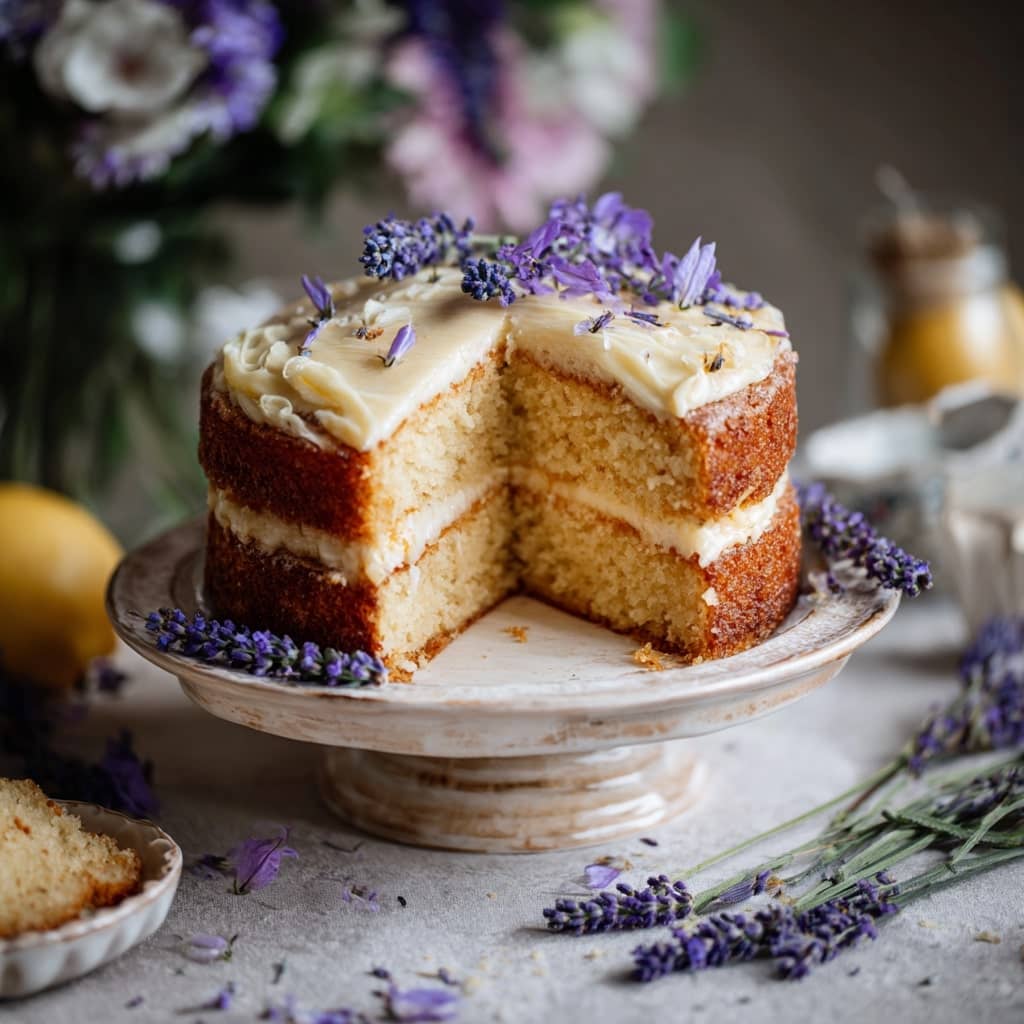Introduction
Lemon Lavender Cake is a delightful fusion of bright citrus flavors and delicate floral notes, resulting in a dessert that is both refreshing and elegantly fragrant. This cake balances the zesty tang of lemon with the subtle, aromatic essence of lavender, creating a sophisticated treat perfect for springtime celebrations, afternoon teas, or any occasion calling for a light yet flavorful dessert. The moist, tender crumb paired with a smooth lemon glaze or buttercream frosting makes it a crowd-pleaser among those who appreciate both classic and inventive flavors. Baking this cake at home offers a chance to infuse natural ingredients and customize sweetness levels, ensuring each bite bursts with freshness and nuanced complexity.
The History of Lemon Lavender Cake
The combination of lemon and lavender in baking reflects a long-standing tradition in European, especially French and Mediterranean, cuisines where herbs and citrus fruits are commonly paired for their complementary flavors. Lavender has been used in cooking and perfumery since ancient times, prized for its aromatic qualities and subtle floral hints. Incorporating lavender into desserts gained popularity in Provence, France, where lavender fields are abundant. Lemon, known for its bright and tangy character, has been a staple in baking worldwide. The idea of pairing these two ingredients in cake form is a more recent innovation in Western baking, reflecting a modern trend towards using culinary herbs and edible flowers in sweets. This cake has since become popular in artisanal bakeries and home kitchens for its unique yet approachable flavor profile.
Ingredients Breakdown
- All-Purpose Flour: Provides structure to the cake, ensuring a tender crumb.
- Baking Powder and Baking Soda: Leavening agents that help the cake rise and become fluffy.
- Salt: Enhances the flavors and balances sweetness.
- Unsalted Butter: Adds richness, moisture, and a creamy texture to the cake.
- Granulated Sugar: Sweetens the cake and contributes to its light texture.
- Eggs: Bind the ingredients together and add moisture and richness.
- Fresh Lemon Juice and Zest: Provide bright, tangy citrus flavor and aroma essential to the cake’s signature taste.
- Culinary Lavender: Finely ground or infused, it lends a gentle floral note without overpowering the lemon.
- Buttermilk or Yogurt: Adds moisture and tenderness while reacting with baking soda for leavening.
- Vanilla Extract: Enhances and rounds out the flavor profile.
- Optional Glaze or Frosting: Typically a lemon glaze made with powdered sugar and lemon juice or a lavender-infused buttercream to complement the cake.
Step-by-Step Recipe
- Preheat and Prepare: Set your oven to 350°F (175°C). Grease and flour a 9-inch round cake pan or line it with parchment paper.
- Mix Dry Ingredients: In a medium bowl, whisk together flour, baking powder, baking soda, salt, and finely ground culinary lavender.
- Cream Butter and Sugar: Using a stand or hand mixer, beat the softened butter and granulated sugar until light and fluffy, about 3–5 minutes.
- Add Eggs: Beat in the eggs one at a time, ensuring each is fully incorporated before adding the next.
- Add Lemon and Vanilla: Mix in the fresh lemon zest, lemon juice, and vanilla extract.
- Alternate Adding Dry Ingredients and Buttermilk: Gradually add the dry ingredients and buttermilk (or yogurt) to the butter mixture in three additions, beginning and ending with the dry ingredients. Mix until just combined after each addition.
- Bake: Pour the batter into the prepared pan and smooth the top. Bake for 30–35 minutes or until a toothpick inserted in the center comes out clean.
- Cool and Glaze: Let the cake cool in the pan for 10 minutes, then transfer to a wire rack to cool completely. Prepare a lemon glaze by mixing powdered sugar with fresh lemon juice and drizzle over the cooled cake, or frost with lavender buttercream if preferred.
Tips for the Perfect Lemon Lavender Cake
Use high-quality, fresh lemons for zest and juice to ensure bright flavor. Avoid overmixing the batter to keep the cake tender and light. When using culinary lavender, ensure it is food-grade and finely ground to prevent a gritty texture and overpowering floral taste. If you prefer a milder lavender flavor, infuse the milk or buttermilk with lavender buds by heating gently and steeping before adding to the batter. Sift your dry ingredients to avoid lumps and to aerate the flour for a lighter crumb. Allow the cake to cool completely before glazing or frosting to prevent melting or sliding. For an even texture, use room-temperature ingredients and measure flour properly by spooning and leveling.
Variations and Customizations
- Lavender Honey Drizzle: Substitute lemon glaze with a warm honey infused with lavender for added sweetness and floral aroma.
- Gluten-Free: Use a gluten-free all-purpose flour blend to make the cake suitable for gluten-sensitive diets.
- Vegan Option: Replace eggs with flax or chia seeds, use plant-based butter and yogurt alternatives.
- Lavender Sugar: Make lavender-infused sugar by blending dried lavender buds with granulated sugar to sprinkle on top before baking or for frosting.
- Lemon Lavender Bundt Cake: Bake the batter in a decorative bundt pan for a stunning presentation.
- Add Berries: Fold fresh blueberries or raspberries into the batter for a fruity twist that complements the floral and citrus flavors.
- Lavender Buttercream Frosting: Use lavender-infused simple syrup when making buttercream for a creamy, floral topping.
Health Considerations and Nutritional Value
Lemon Lavender Cake is a moderately indulgent dessert rich in sugars, fats, and calories primarily from butter, sugar, and eggs. The presence of fresh lemon adds vitamin C and antioxidants, while culinary lavender may offer calming properties and antioxidants, though used in small quantities. Using buttermilk or yogurt adds beneficial probiotics and calcium. To make this dessert healthier, consider reducing sugar or substituting with natural sweeteners like honey or maple syrup, and use whole wheat flour or almond flour for added fiber and nutrients. Portion control is important as the cake can be calorie-dense. Those with allergies to eggs or dairy should seek suitable substitutes. Also, use food-grade lavender to avoid any adverse reactions.
FAQ
Can I use dried lavender instead of fresh? Yes, but ensure it is culinary-grade and use sparingly to avoid bitterness.
How do I prevent the lavender from overpowering the cake? Grind the lavender finely and use small amounts; infusing liquids is another gentler method.
Can I make this cake ahead of time? Yes, it can be baked a day ahead and stored in an airtight container. Glaze or frost just before serving.
What’s the best frosting for this cake? A lemon glaze or lavender buttercream pairs beautifully.
Can I freeze this cake? Yes, wrap well and freeze for up to 3 months. Thaw in the refrigerator before serving.
Is this cake suitable for children? Yes, it contains no alcohol or strong flavors that are unsuitable for kids.

Lemon Lavender Cake Recipe
Ingredients
Cake Ingredients:
- 1 cup 200 g / 7 oz granulated sugar
- 2 tablespoons lemon zest
- 3 tablespoons culinary lavender
- 3/4 cup 170 g / 6 oz salted butter, softened to room temperature
- 3 large eggs at room temperature
- 3 tablespoons lemon juice
- 2 cups 240 g / 9.5 oz all-purpose flour
- 1 teaspoon baking powder
- 1/2 cup 120 ml / 4 fl oz whole milk, at room temperature
Lavender Glaze Ingredients:
- 1 1/2 cups 180 g / 6 oz powdered sugar, sifted
- 3 to 4 tablespoons whole milk
- 1/2 teaspoon lavender extract
- 2 to 3 drops purple food coloring
Instructions
- Prepare your workspace by preheating the oven to 350°F (180°C / gas mark 4). Grease the bottom and sides of a 9×5-inch (23 x 12 cm) loaf pan, then line it with parchment paper, leaving the paper to hang over the edges for easy cake removal.
- In a medium bowl, whisk together the flour and baking powder, then set aside.
- Create the lemon lavender sugar by placing the granulated sugar, culinary lavender, and lemon zest into a large mixing bowl. Rub the lemon zest and lavender buds into the sugar to release the oils and infuse the sugar with their aroma.
- Add the softened butter to the infused sugar mixture and cream together using an electric mixer until the mixture becomes light and fluffy, about 2 to 3 minutes.
- With the mixer set to medium speed, add the eggs one at a time, fully incorporating each egg before adding the next. Use a rubber spatula to scrape down the bowl sides as needed. Then mix in the fresh lemon juice.
- Add half of the flour mixture to the wet ingredients and mix until just combined. Pour in the milk, mixing gently, then add the remaining flour mixture and stir until the batter is smooth with no visible flour streaks.
- Pour the batter evenly into the prepared loaf pan, smoothing the top.
- Bake for 50 to 60 minutes, or until the cake’s top is golden brown and a skewer inserted in the center comes out clean or with just a few moist crumbs, but no wet batter.
- Allow the cake to cool in the pan for 15 minutes before lifting it out using the parchment paper overhang. Transfer to a wire rack to cool completely and remove the parchment paper once cold.
- To prepare the glaze, whisk together the sifted powdered sugar, milk, and lavender extract in a medium bowl until smooth. Add a few drops of purple food coloring to tint the glaze. Adjust consistency by adding more powdered sugar if too thin, or more milk if too thick.
- Drizzle the glaze over the cooled cake loaf and let it set for a few minutes. Slice and serve your beautifully flavored lemon lavender cake.

